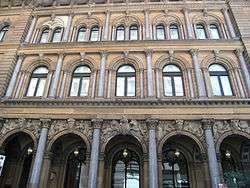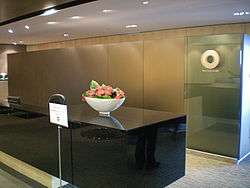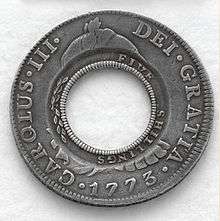Macquarie Group
 | |
| Public | |
| Traded as |
ASX: MQG OTC Pink: MQBKY |
| Industry | Diversified Financials |
| Founded |
1970 Sydney, New South Wales, Australia |
| Headquarters |
No. 50 Martin Place New South Wales Australia |
Key people |
Peter Warne, Chairman Nicholas W. Moore, CEO |
| Products | Financial Services |
| Revenue | AUD A$8.1 billion (2014)[1] |
| AUD A$2.06 billion (2016) | |
| Total assets | AUD A$122 billion (2016) |
Number of employees | 14,200 (June 2012) |
| Website |
www |
Macquarie Group Limited is a global investment banking and diversified financial services group, providing banking, financial advisory and investment and funds management services to institutional, corporate and retail clients and counterparties around the world. Headquartered in Sydney, Macquarie is the largest Australian investment bank and the top ranked mergers and acquisitions advisor in Australia.[2]
Macquarie is listed in Australia (ASX:MQG) and is regulated by APRA, the Australian banking regulator, as the owner of Macquarie Bank Limited, an authorised deposit taker.
The company's high margins, profits and the lucrative rewards for its executives and shareholders saw the Australian media label the bank "The Millionaire Factory" due to their notably strong performances.[3] As of May 6, 2016, the group's chief executive Nicholas Moore became the nation's highest paid CEO of a listed company as they announced a net profit after tax for the year at A$2.06 billion.
History
Macquarie was founded in 1969 and it began its operation, with only three staff, from Sydney in January 1970 as Hill Samuel Australia, a subsidiary of the UK's Hill Samuel.
Hill Samuel initially sought the advice of Sir John Marks, of Development Finance Corporation (DFC), regarding the establishment of an Australian subsidiary, however he suggested that Stan Owens instead be the one to compile a proposal for consideration. After presenting his report in London, Mr Owens was offered the role of implementing it by Hill Samuel's Chairman, Kenneth Keith, Baron Keith of Castleacre. Mr Owens became Executive Chairman of Hill Samuel Australia (HSA) and founded the company in Gold Fields House in Sydney's Circular Quay. The company's first three employees were Stan Owens, Blair Hesketh and Geoff Hobson Later Chris Castleman(on loan from the British parent) and Bill Clarke joined. David Clarke and Mark Johnson (both formerly of Darling & Co) were introduced to HSA and became joint Managing Directors. Despite being given a four-year allowance by the British parent to turn a profit, HSA was profitable by the end of its first twelve months of trading. In 1971 HSA secured Australia’s biggest mandate at the time, a $US60 million financing for corrugated iron manufacturer John Lysaght Australia. In 1981, in response to changes evolving from the deregulation of financial markets, Hill Samuel Australia commenced work on a proposal to become a trading bank. In 1983 Stan Owens died and was succeeded by David Clarke. Authority for Hill Samuel Australia to become Macquarie Bank Limited (MBL) was received from the Federal Treasurer in 1985, making it only the second private trading bank to be established in Australia in modern times. Macquarie took its name from Lachlan Macquarie, an early Governor of New South Wales who dramatically transformed the early settlement in Australia from a penal colony into a dynamic economy. Macquarie Bank took over Hill Samuel Australia and opened its doors for business in 1985 in Sydney. A trading bank was opened in Melbourne the same year and in Brisbane in November 1986. The company listed on the ASX in 1996, and on 30 October 1996 entered the ASX's All Ordinaries Index, with a market capitalisation of approximately $1.3 billion. In 2007, MBL securityholders and the Federal Court approved the restructure of the Macquarie group into a non-operating holding company (NOHC) structure. The NOHC and ultimate parent of the Macquarie group, Macquarie Group Limited, is ASX listed.[4] Macquarie Group is regulated by APRA, the Australian banking regulator, as the owner of Macquarie Bank Limited, an authorised deposit taker.[5]
Macquarie manages a number of listed and unlisted investment funds which contributed approximately 12 percent of Macquarie's total underlying operating income for the half year ended 30 September 2009. The funds own assets that deliver services including transport, roads, airports and utilities.
Recent news and investments
In January 2015, Macquarie Group acquired a stake in Baltic 2 offshore wind park from EnBW for a fee totalling €720 million, due for completion in summer 2016 and subject to antitrust approval.[6]
Later in May that year, the group jointly acquired Australia's largest owner of mobile phone towers Crown Castle Australia Holdings for an undisclosed price, rumoured to be in the region of $1.62 billion, from its ultimate owner, Crown Castle International Corp.[7]
Global reach


Macquarie employs more than 14,000 staff in more than 70 office locations across 28 countries.[5] Macquarie's operations are now global with staff located in the following countries: Australia, Austria, Brazil, Canada, China, Germany, France, Argentina, India, Indonesia, Ireland, Luxembourg, Japan, Korea, Malaysia, Mexico, Netherlands, New Zealand, Philippines, Russia, Singapore, South Africa, Sweden, Switzerland, Taiwan, Thailand, United Arab Emirates, United Kingdom and the United States.
In 2009 Macquarie acquired:
- Condor Ferries, service between the UK, Channel Islands and France
- The equity derivatives and structured products business of German private bank Sal. Oppenheim
- Blackmont Capital Inc, a Canadian wealth management business, from CI Financial
- Fox-Pitt Kelton Cochran Caronia Waller, a leading specialist investment bank focused on financial institutions
- Delaware Investments, a leading US-based diversified asset management firm, from Lincoln Financial Group
- Tristone Capital Global Inc, an independent energy advisory firm
- The wholesale electricity trading business of US firm Integrys Energy
Business structure
Macquarie's business activities are organised into six principal operating groups: Macquarie Capital (formerly Investment Banking Group), Macquarie Securities Group (MSG), Commodities and Financial Markets (formerly Fixed Income, Currencies and Commodities (FICC)), Macquarie Asset Management (formerly Macquarie Funds Group (MFG)),the Banking and Financial Services Group (BFS), Financing & Investing / Corporate and Asset Finance (CAF) - Macquarie's principal investing group.[8] In addition to the operating groups, Macquarie has a network of support areas: Corporate Affairs Group, Market Operations and Technology (Formerly Information Technology Group) and Risk Management Group.
Macquarie's managing director and chief executive officer is Nicholas Moore, who replaced Allan Moss in May 2008, and the board chairman is David Clarke who served as Executive Director from 1985 to 2007, and Chairman from 2007 to 2011.[9]
In 2005 Macquarie announced a hostile takeover bid for the London Stock Exchange valuing the company at £1.5 billion, a bid rejected by LSE management as "derisory".
In 2007 the bank, together with a number of private equity firms, unsuccessfully attempted to take over Qantas.
Current board members
- H. Kevin McCann AM - Independent Chairman; former Partner and Chairman of Allens Arthur Robinson
- Nicholas W. Moore - Managing Director and Chief Executive Officer; Executive Voting Director
- Gary R Banks AO - Independent Voting Director; Dean and Chief Executive Officer of the Australia and New Zealand School of Government
- Gordon M Cairns - Independent Voting Director; former CEO of Lion Nathan; former chairman of David Jones Limited
- Michael J Coleman - Independent Voting Director; former senior audit partner with KPMG
- Patricia A Cross - Independent Voting Director; director of Aviva plc and the Australian Institute of Company Directors, founding director of Grattan Institute
- Diane J Grady AM - Independent Voting Director; member of the McKinsey Advisory Council
- Michael J. Hawker - Independent Voting Director; former CEO of Insurance Australia Group
- Nicola Wakefield-Evans - Independent Voting Director; former partner of King & Wood Mallesons; member of Takeovers Panel
- Peter H. Warne - Independent Voting Director; former head of Bankers Trust Australia Limited’s Financial Markets Group
Notable current and former employees
Business
- Simon Hannes - executive director and investment banker, convicted of insider trading
- Greg Coffey - hedge fund manager
- Jeremy Balkin - author
Public service
Macquarie Bank maintains political connections through the appointment of former politicians and senior political staffers to senior positions.
- Bob Carr - Premier (1995–2005) of the Australian state of New South Wales
- Max Moore-Wilton - former Secretary of the Australian Department of the Prime Minister and Cabinet to John Howard
- Graeme Samuel - chairman of the Australian Competition and Consumer Commission (2003–present)
- Warwick Smith - former Australian Federal Cabinet Minister
- Alan Stockdale - former Treasurer of the Australian state of Victoria
Logo

Macquarie Group's logo is a representation of the 'Holey dollar', Australia's first coinage, created by Governor Macquarie to overcome a currency shortage faced by the early Australian settlers. The official explanation is that Governor Macquarie's creation of the Holey Dollar was "an inspired solution to a difficult problem and for this reason it was chosen as the symbol of the Macquarie Group."
Criticism
Macquarie Group through its subsidiary Macquarie Equipment Rentals has allegedly been perpetrating a Telco finance scam. Macquarie Equipment Rentals has sued over 300 victims of the scam which involves bundling a finance equipment contract with a contract from a small telecommunications company, often obscuring that the finance contract exists.[11]
The scam involves the telecommunications company promising free equipment such as Plasma TVs, while offering a lower cost phone deal that offsets the cost of the equipment. The victim is then tricked into signing two contracts with the true costs often hidden, whilst being verbally promised that they will be free. The telecommunications company is paid an upfront fee by the finance company, and sometime later disappears. The victim is then left with an inflated finance company lease that requires the victim to pay often tens of thousands of dollars for equipment that in reality costs a fraction of the price.[12]
The company's high margins and profits, and the rewards for its executives and shareholders, saw the Australian media label the bank "The Millionaire Factory" up until its share price fell almost 85% in early 2009.[13]
See also
- Australian real estate investment trust
- Banking in Australia
- Better Place
- List of banks
- List of banks in Australia
- List of banks in Oceania
- Macquarie Power & Infrastructure Income Fund
- Kemble Water Holdings Limited
- Macquarie Airports
- Southern Cross Media Group
References
- ↑ "Annual Results 2014" (PDF). Macquarie Group. Retrieved 30 May 2014.
- ↑ ThomsonReuters.com
- ↑ "Return of the 'millionaire's factory': Macquarie Bank splashing the cash again". The Sydney Morning Herald.
- ↑ "About - History - Macquarie Group".
- 1 2 "Company profile - Macquarie Group".
- ↑ EnBW sells offshore windpark stake to Macquarie for 720 million euros. Reuters, 8 January 2015
- ↑ Macquarie-led group pays $1.6 billion for Crown Castle wireless towers, Reuters, 14 May 2015
- ↑ "Macquarie's six major business Groups". Macquarie Group.
- ↑ Sydney Morning Herald (2011). Macquarie veteran dies. Retrieved 9 April 2011.
- ↑ "Leadership and corporate governance".
- ↑ "Samuel slams Macquarie over telco scam". The Sydney Morning Herald. 1 November 2010.
- ↑ "Macquarie slammed over alleged telco-finance scam". ABC News.
- ↑ "Can Macquarie Again Become a Millionaires Factory?".
External links
- Company Profile
- Macquarie's Infrastructure Vehicles, under "Products"
- Macquarie Group companies grouped at OpenCorporates